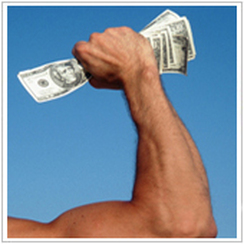
How can learning how to invest make my waistline smaller? Keep reading and we’ll tell you!
Your investment strategy
As a personal trainer, I love when I am able to use analogies that correspond with my clients’
occupations to help them develop wellness systems that are repeatable, sustainable and that deliver
results. None of these occupations work better than that of the financial planners I have worked with
because the concept of investing goes hand in hand with improving your overall health and wellness.
Here is how you can use their strategies to help you lose weight, run a 5K or create a firm, trim waistline.
Seek the professional help: I used to think I was good at saving and investing and for the most part,
I was decent. It wasn’t until I sat down with my financial planner (who is also a client of IWC) that I
fully understood what I would need to do in order to plan for the type of retirement Beth and I dreamt
about. I was saving A LOT but keeping the cash in a low interest money market account vs. putting it in
the type of investments that would give me a greater return. The same can be said for your workout.
You may be doing a decent job exercising but working with a certified and experienced personal trainer
will allow you to create a plan that will produce greater returns in a shorter amount of time.
What is your risk tolerance?: In finance, there are some who cannot stand the thought of investing in
higher risk stocks while others throw caution to the wind and are willing to invest in everything from
international stocks to newer, unproven companies that show potential for growth. It is about what you
are comfortable with. In fitness, your options for exercise are darn near limitless. Any activity is great
but it has to fit your likes, personality, and conditioning level to feel comfortable enough to stick to your
plan. Before starting, gauge your risk tolerance and choose activities you'll enjoy and stick with.
How much can you invest:
Knowing how much money you have to put in a 401K, money market or IRA
is incredibly important. It doesn’t matter if it is $100 or $1,000 per month, figure out how much you can
set aside after you have paid your bills, bought groceries, filled up your car and maybe take in a movie
or dinner with your significant other (you have to live a little). Want to know what the biggest excuse
for not exercising is? I don’t have time. Well, much like consciously setting aside money to invest vs.
spending it on eating out or “things” you don’t need, make time by going through your daily schedule
and building in your workout sessions. For some this might be an hour a day. For others, it could mean
a ten minute walk every day at lunch. Oh, and the time is there. How much do you spend on social
media, watching TV or procrastinating every day?
If you look, there are easily 20-30 minutes you can find to invest in physical activity.
But won’t you get a better return financial investing $1,000 vs. $100 or better weight loss results
exercising an hour vs. ten minutes? Of course you will, but you have to set the level of time investment
that will work for your current place in life. Much like we can always invest more as our income grows,
you can find new and better ways to fit additional exercise time in your life.
Dollar Cost Averaging:
This is a concept where you invest the same amount on a monthly basis no
matter how well or poor the market is doing. If your investments are not doing well, your $100 (or
more) per month will buy more shares than when the investment is doing well and has a higher share
price. In fitness, we all have highs and lows in motivation and some workouts will feel like you are just
going through the motions while others will be filled with so much motivation you’ll feel like a gold
medalist. The important point to remember is to be consistent over time with the amount of energy
you can invest and you will see a greater return. You cannot invest $100 one month and nothing the
next and expect a healthy portfolio. The same can be said for working out for an hour on Monday and
not returning to the gym until the following week. As with exercise and investing, you see the greatest
returns when you remain consistent with the amount (time and money) you are comfortable investing.
Health and finances go hand in hand and by following these tips for both your financial and physical
fitness, you can expect amazing results in both your bank account and waistline for years to come!



 RSS Feed
RSS Feed
